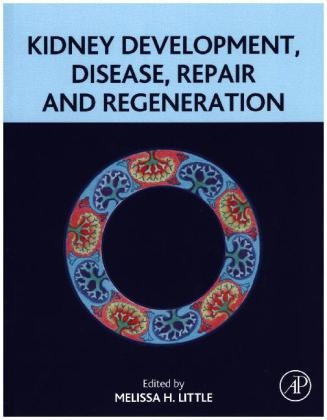
Kidney Development, Disease, Repair and Regeneration
Academic Press Inc (Verlag)
978-0-12-800102-8 (ISBN)
Professor Melissa Little is an NHMRC Senior Principal Research Fellow at the Murdoch Children’s Research Institute, Royal Children’s Hospital, Melbourne and is a Professor in the Faculty of Medicine, Dentistry and Health Sciences, University of Melbourne, Australia. An alumnus of The University of Queensland, Australia, she worked for more than 20 years at the Institute for Molecular Bioscience, where her research has focused on the molecular basis of kidney development, renal disease, and repair. She is internationally recognized both for her work on the systems biology of kidney development and also for her pioneering studies into potential regenerative therapies in the kidney. Her research now focuses on the generation of mini-kidneys from patient stem cells for use in drug screening and disease modelling. Professor Little is a recipient of the GlaxoSmithKline Award for Research Excellence (2005), Gottschalk Medal (2004), Eisenhower Fellowship (2006) and a Boorhaave Professorship (2015). From 2007-2008, she served as the Chief Scientific Officer at the Australian Stem Cell Centre and is currently the Vice President of the Australasian Society for Stem Cell Research. Professor Little is also on the editorial board of the Journal of the American Society for Nephrology, Kidney International, Development and Developmental Biology. Her appreciation for the wonder of developmental biology also stems from her role as the mother of two beautiful children.
Section 1: Development
Development - Introduction
1. Zebrafish renal development and regeneration
2. Early specification and patterning of the intermediate mesoderm: genetics and epigenetics
3. The human kidney: parallels in structure, spatial development and timing of nephrogenesis
4. Growth factor signalling in UB branching
5. Quantification of branching morphogenesis
6. Transcriptional regulation of the nephrogenic mesenchyme and its progeny
7. The role of growth factors in balancing cap mesenchyme survival and differentiation
8. Notch signalling in nephron segmentation
9. Genetic and epigenetic regulation of nephron number in the human
10. Formation and maintenance of a functional glomerulus
11. Maturation and roles of collecting ducts and loops of Henle in renal medulla development
12. Balancing self-renewal and differentiation: the role of the stroma
13. The origin and regulation of the renal vasculature
Section 2: Disease
Disease - Introduction
14. Variation in nephron number and association with disease.
15. The effect of the in utero environment on nephrogenesis and renal function
16. Persistence of the nephrogenic mesenchyme in disease: the role of WT1
17. Wnts, Notch and tubular pathology
18. Regulation of ureteric bud outgrowth and the consequences of disrupted development
19. Abnormal ureter-bladder connections are associated
20. Polycystic kidney disease: underlying causes, consequences and variation between mouse and man.
21. Genetic aspects of human congenital anomalies of kidney and urinary tract
22. Inherited kidney disorders in the age of genomics
23. Fibrosis: a failure of normal repair and a common pathway to organ failure
Section 3: Repair
Repair - Introduction
24. Postnatal cell turnover in the nephron epithelium: what can this tell us
25. Plasticity within the collecting ducts: what role does this play in response to injury
26. The onset and resolution of renal fibrosis: a human perspective
27. Chronic renal damage: how does this suppress normal repair processes
28. Investigating the process of renal epithelial repair to develop new therapies
29. Evidence for renal progenitors in the human kidney
30. The papilla as a source of kidney progenitors
31. A positive role for the macrophage in renal repair
32. The use of MSCs for treating acute renal injury and modulating rejection
Section 4: Regeneration
Regeneration - Introduction
33. Reprogramming to the nephron progenitor state
34. From development to regeneration: kidney reconstitution in vitro and in vivo.
35. Directing the differentiation of pluripotent cells to renal endpoints
36. Patient-derived iPS cells: what can they teach us?
37. Xenotransplantation in the kidney: an historical perspective
38. The use of the nephrogenic niche of a xeno-embryo for commitment to kidney
39. Human fetal kidneys for renal regenerative medicine: from rudiments to nephron stem/progenitor cells
40. Renal replacement approaches using deceased donor sources
41. Tissue Engineering through Additive Manufacturing: Hope for a bioengineered kidney?
42. Decellularised scaffolds for the recreation of organs
| Verlagsort | San Diego |
|---|---|
| Sprache | englisch |
| Maße | 216 x 276 mm |
| Gewicht | 1930 g |
| Themenwelt | Medizinische Fachgebiete ► Innere Medizin ► Nephrologie |
| Medizin / Pharmazie ► Medizinische Fachgebiete ► Urologie | |
| ISBN-10 | 0-12-800102-X / 012800102X |
| ISBN-13 | 978-0-12-800102-8 / 9780128001028 |
| Zustand | Neuware |
| Haben Sie eine Frage zum Produkt? |
aus dem Bereich


